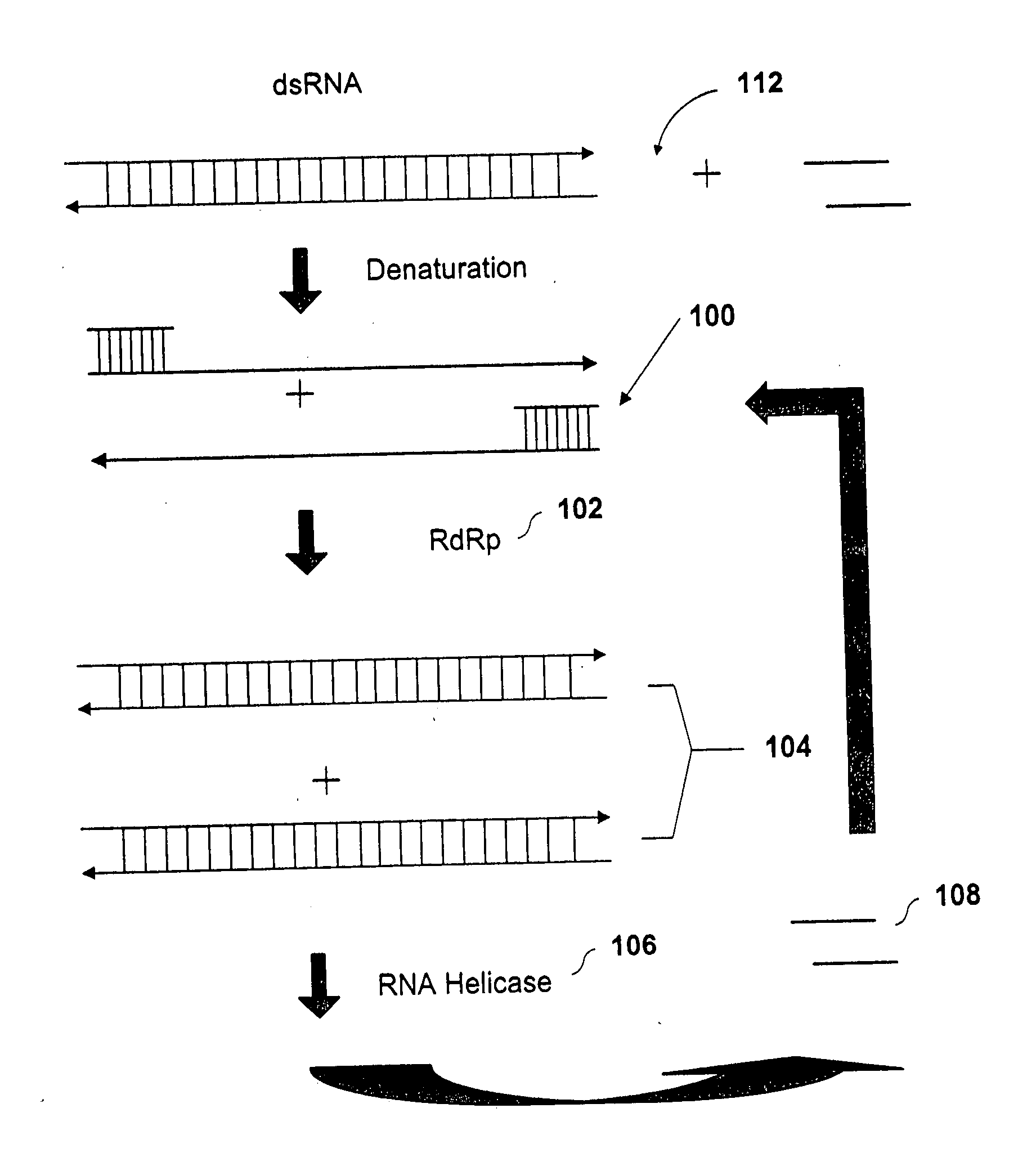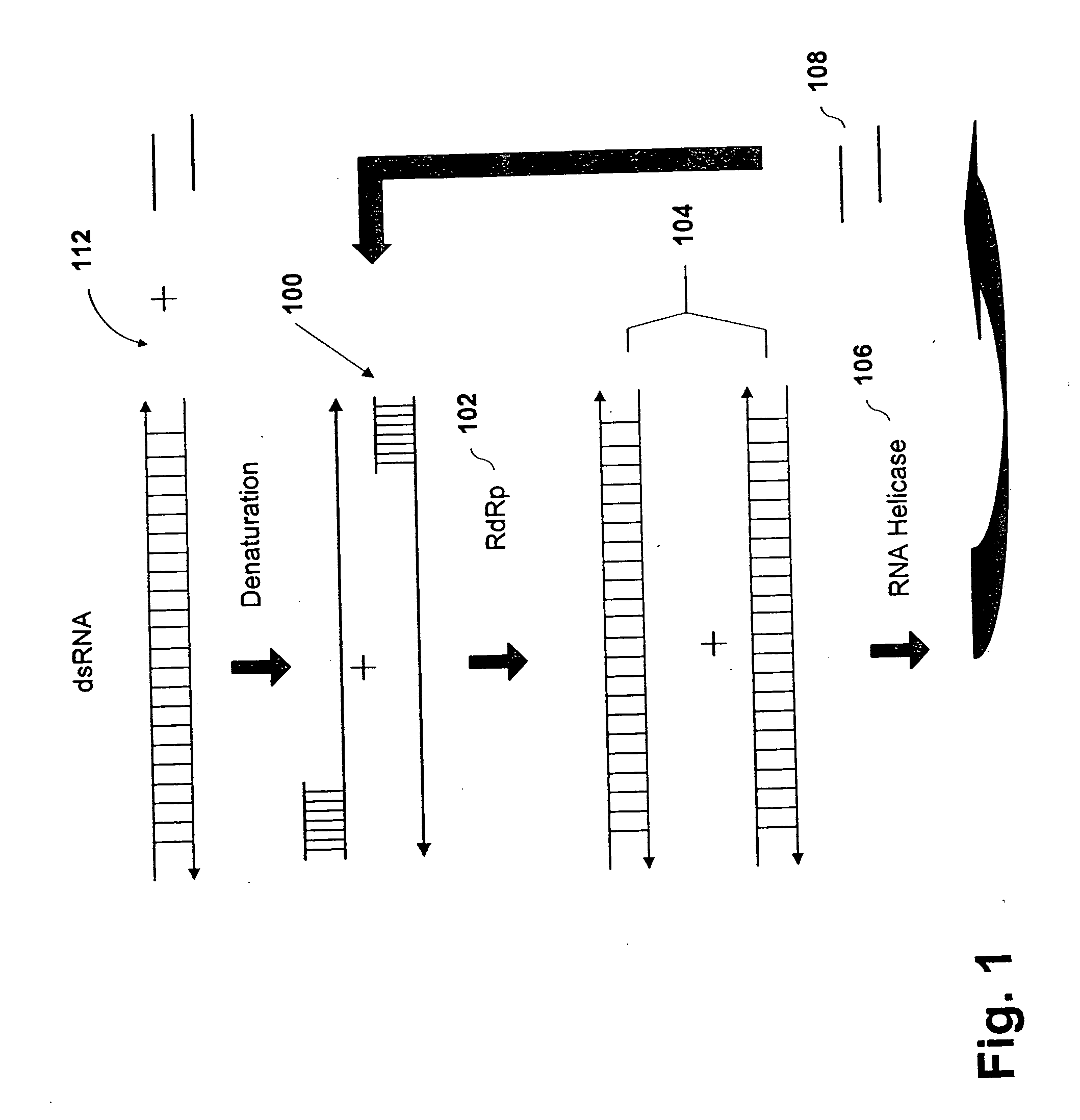Methods and compositions for RNA amplification and detection using an RNA-dependent RNA-polymerase
a technology of rna and rna-polymerase, which is applied in the field of methods and compositions for rna amplification and detection using an rna-dependent rna-polymerase, can solve the problems of insufficient in vitro production of rna, limited advancement into other potential fields of rna use, and impeded these interests
- Summary
- Abstract
- Description
- Claims
- Application Information
AI Technical Summary
Benefits of technology
Problems solved by technology
Method used
Image
Examples
example one
[0130] Sub-Cloning, Expression, and Purification of Tomato RNA-dependent RNA-Polymerase
[0131] 1. Sub-Cloning
[0132] A nucleic acid sequence for Tomato RNA-dependent RNA-polymerase was codon optimized for expression in E. coli, Chemically synthesized and cloned into PJ1 vector by DNA 2.0 (Minlo Park, Calif.). The PJ1 Vector with insert arrived in an agar slab after transformation into XL 1 Blue cells. Colonies from the agar slab were grown overnight at 37° C. in 2YT media (Teknova, Hollister, Calif.). The plasmids were purified using a Prefect Prep Midi kit (Eppendorf AG, Hamburg, Germany) followed by ethanol precipitation. The final pellets were dissolved in 600 μL of molecular biology grade water. The PJ1 vectors were then restriction enzyme digested with NcoI and XhoI (New England Biolabs, Beverly, Mass.) for subcloning into pET19b (Novagen, San Diego, Calif.). The pET19b-RdRP was transformed into BL21 cells and plated onto LB-amp plates (Teknova, Hollister, Calif.) for overnight...
example two
[0143] Amplification of RNA Template Using Temperature Cycling
[0144] The following example is provided to illustrate the prospective utility for amplifying a target RNA, under temperature cycling conditions, using a recombinant tomato RdRP. A reaction mixture having 0.5 μg RdRp, 0.02 pmol target RNA, 100-300 nM primer 1 (SEQ. ID. No. 3) (5′-ggaugcauagcuugaguauuc-3′), 100-300 nM primer 2 (SEQ. ID. No. 4) (5′-cacaggaaacagcuaugac-3′), 0.2-0.5 mM rNTPs in 20 mM Tris-HCL, pH 7.5, 70 mM KCl, 2-10 mM MgoAc, 1.5 mM DTT, 20 U Rnasin or other like RNase inhibitor. A final reaction volume of 20 μL is obtained. The reaction is incubate between 70-85° C. to separate the duplex strands of the template followed by reaction cooling to 35-45° C. During the temperature reduction, the primers bind to the complement sequences on opposite strands of the target RNA. Once the temperature reaches the optimized range, 0.5 μg of RdRp is added to the reaction mixture for strand extension. This process is rep...
example three
[0146] Amplification of RNA Template Using a RNA Helicase
[0147] The following Example is provided to illustrate the prospective utility for amplifying a target RNA using a tomato derived RdRp and an RNA helicase (eIF-4A and eIF-4B) in a single reaction mix. A reaction mixture having 0.5 μg RdRp, 2 μg recombinant eIF-4A, 0.5 μg recombinant eIF-4B, 0.02 pmol target RNA, 100-300 nM primer 1 (SEQ. ID. No. 5) (5′-ggaugcauagcuugaguauuc-3′), 100-300 nM primer 2 (SEQ. ID. No. 6) (5′-cacaggaaacagcuaugac-3′), 0.2-0.5 mM rNTPs in 20 mM Tris-HCl, pH 7.5, 70 mM KCl, 0.5 mM MgoAc, 1.5 mM DTT, 0.5 mM ATP, 20 U RNasin or other like RNase inhibitor is prepared. A final reaction volume of 20 μl is obtained. The reaction is allowed to incubate for approximately 30 minutes to one hour at 35-45° C.
[0148] Reaction products are analyzed through a combination of spectroscopy and gel electrophoresis. Note that recombinant eIF-4A and -4B can be obtained using the methods described in Pause et al., Mol. Cel...
PUM
| Property | Measurement | Unit |
|---|---|---|
| Molar density | aaaaa | aaaaa |
| Molar density | aaaaa | aaaaa |
| Fraction | aaaaa | aaaaa |
Abstract
Description
Claims
Application Information
 Login to View More
Login to View More - R&D
- Intellectual Property
- Life Sciences
- Materials
- Tech Scout
- Unparalleled Data Quality
- Higher Quality Content
- 60% Fewer Hallucinations
Browse by: Latest US Patents, China's latest patents, Technical Efficacy Thesaurus, Application Domain, Technology Topic, Popular Technical Reports.
© 2025 PatSnap. All rights reserved.Legal|Privacy policy|Modern Slavery Act Transparency Statement|Sitemap|About US| Contact US: help@patsnap.com



